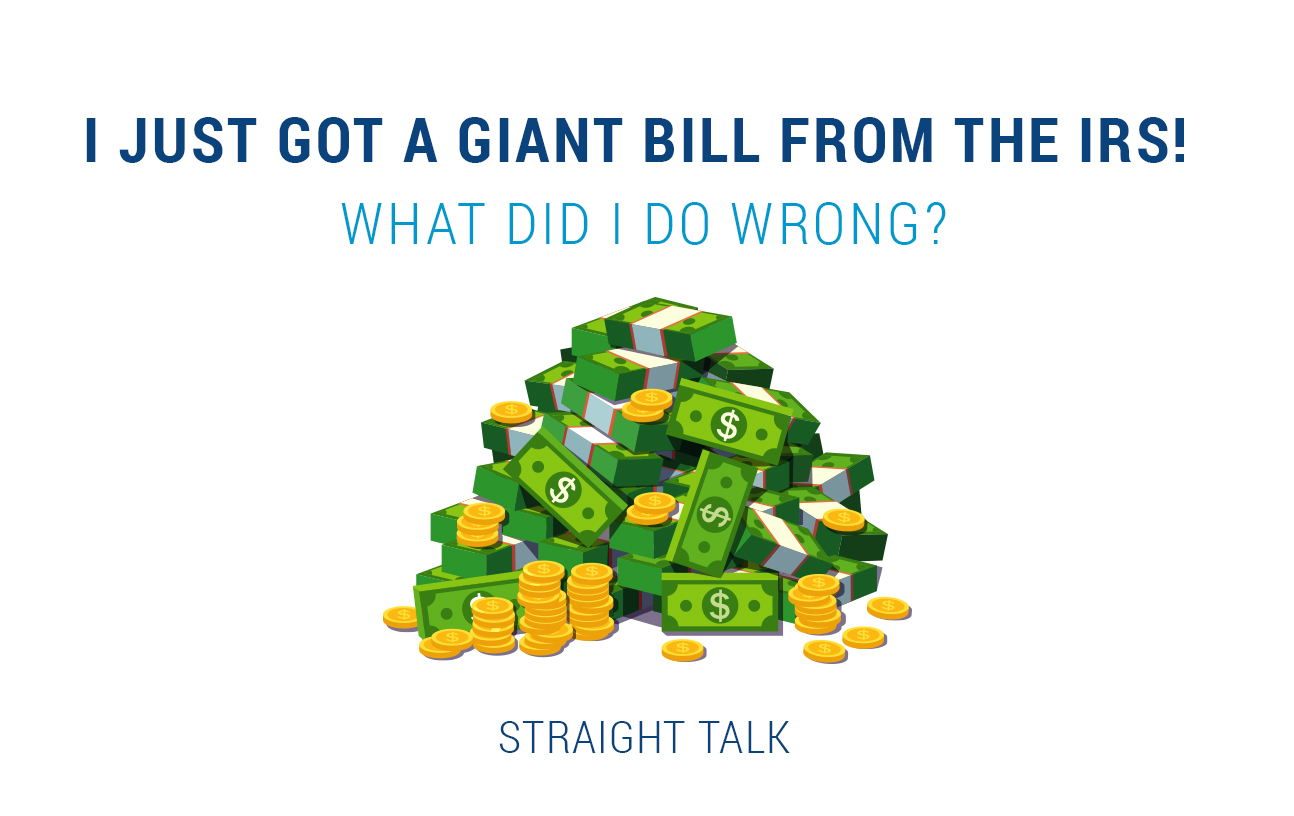As I sit here in mid-April, I can’t help but think of all the times in the past four years I’ve been confronted by folks who got HUGE tax bills at the end of the year because they bought their health insurance on healthcare.gov, made some errors computing their income and got hit with a surprise bill. This is a great time to review how the Advanced PremiumTax Credits on healthcare.gov work and how to avoid getting nailed with a huge tax bill at the end of the year.
I remember as my career advanced in the 1980s and 90s, I started out getting a nice income tax refund every year, and those lumps of money came in very handy. The expectation of getting a refund became part of my budgeting process — if we could survive until February or March and get that big chunk of money back! Ah, those were the days!
But, as you make more money and life gets more complex, it gets really hard to get right what you should be withholding during the year. In the past 10 years, I’ve owed money almost every year.
If you use healthcare.gov for your health insurance, and you don’t carefully, carefully estimate your income and tweak it during the year as things change or when you see discrepancies, you can end up owing the IRS a ton of money.
Financial Aid for Healthcare
Health insurance premiums since the Affordable Care Act (ACA) can get very expensive. Very, very expensive.
For example, buying a lower-end Silver plan on healthcare.gov in 2017 for someone my age (56) costs more than $903 a month. That’s $10,845 a year! Wow!
Now, imagine a household of three people, the Johnson family — let’s call them Jim, age 56, Jane, age 56, and Jolene, age 21 – buying that same policy. Now we are talking about $26,028 a year ($2,169/month!) in health insurance premiums! Like buying a nice, new car every year, right?
Who can afford that?
The federal government, through the IRS, is ready, willing and able to help you pay that enormous bill, if you follow their rules very carefully. Very carefully. In fact, if your income is in the right zone, they will give you money (the Advanced Premium Tax Credit) to help you pay your premiums!
Keeping Up With the Johnsons
Continuing our example with the Johnson family above, if we ask Jim, Jane and Jolene what their household income is going to be next year, they might have the kind of jobs where those numbers are predictable.
Then again, they may not. Or, they may have a huge windfall during the year (YAY!), or they may suffer a big loss of income (BOO!). In any event, when these things happen, most people don’t immediately think, “Oh, I’d better give healthcare.gov a ring and let them know to increase/decrease my projected income!” Usually, people have bigger fish to fry. Until they do their taxes, that is.
So, recently, the Johnson family (not their real names) got a very large bill from the IRS when they did their taxes. Very large.
You see, back in December 2016, they projected their income for 2017 to be $51,050 for the household. That works out to 250% of the Federal Poverty Line. With that income, even though they were purchasing insurance that costs $26,019 for an entire year (notice that’s more than HALF their GROSS projected income), healthcare.gov was ready, willing and able to provide them $19,251 in Advanced Tax Credits!
With that payment help, the Johnsons didn’t have to pay $26,019 for 2017.They paid just $6,768 out of their own pockets in premiums, or roughly $566 a month. Let’s table that to make it simple and look at the entire 12 months at once (I’ve rounded the numbers for you):
| At 250% of FPL… |
Member Pays (Annual) |
|
Government Pays (Annual) |
|
Total Premium (Annual) |
|
Jim |
$2,256 |
+ |
$8,585 |
= |
$10,841 |
|
Jane |
$2,256 |
+ |
$8,585 |
= |
$10,841 |
|
Jolene |
$2,256 |
+ |
$2,081 |
= |
$4,337 |
|
Total Family |
$6,768 |
+ |
$19,251 |
= |
$26,019 |
Assumptions: Buying benchmark Silver plan in ZIP code 70810 for 2017. Income at 250% of FPL is a household income of $51,050 (modified adjusted gross income) for 2017 tax year.
Now, as long as the Johnsons correctly estimated their 2017 income, when they do their 2017 taxes (in early 2018), the federal tax credits they received (more than $19,000) won’t affect their liability to the IRS. But, in this case, that’s not what happened.
In April 2017, Jane got a better, higher-paying job. In August, Jim got a really big raise. By the end of 2017, the family had a recorded income of $81,000 and their Modified Adjusted Gross Income was almost $82,000! What a great year they had! And the Johnsons went to bed thankful on New Year’s Eve.
But then they had to wake up. And do their taxes. And at $82,000 for a family of three, they were entitled to healthcare advanced tax credits of… ready? $0. Zero dollars.
Yep, you heard me right. Nothing. The entire amount they got, all $19,251 in healthcare advanced tax credits, would have to be paid back to the IRS! Ouch!
Hindsight Is 20/20
So, what should the Johnsons have done to avoid this situation?
According to healthcare.gov, people who get Advanced Tax Credits during the year must notify them when their income changes, either up or down. When Jane got her better job, she should have celebrated that by telling healthcare.gov to raise their premiums. When Jim got that big raise he had been waiting for, he should have partied hard on the phone with healthcare.gov again, telling them to raise their premiums and reduce the Advanced Premium Tax Credits again. That’s what they were supposed to do.
Because they failed to do this, and they made lots more money than they thought they would when they had to predict their 2017 income at the end of 2016, the IRS expects them to pay back all $19,251 they got in Advanced Premium Tax Credits.
Now, if the Johnsons’ final income had been LESS than 400% of the Federal Poverty Line, there would have been a cap on the amount they have to repay. If they had made $78,000 instead of $82,000, then they would have paid back less. But, once your income passes 400% of the Federal Poverty Line for your household size, you owe ALL the money back!
The Moral of the Story
The moral of the story is, if you are taking money from healthcare.gov to help pay your health insurance premiums, make sure healthcare.gov always knows your latest projection of how much money you are going to make. Failing to do that could result in a very big tax bill come the following year. Just like the poor Johnson family.
It Works the Other Way, Too
Finally, I’d like to leave you on a positive note by reminding you that the opposite effect is just as true. If the Johnsons, back during open enrollment in 2016, had projected their income to be $82,000 for 2017 and then only made $51,050, had kept their healthcare.gov insurance and paid the premiums out of their own pocket, the IRS would have cheerfully refunded them the $19,251 when they completed their taxes, as long as they bought a plan from healthcare.gov. This particular door swings both ways.
So please, please, if you or a family member gets assistance from healthcare.gov to pay health insurance premiums, it is critical that you keep them well aware of your latest and greatest projection for your total-year income is. Keep this in mind when things happen like you get a raise, change jobs, lose a job, have a death in the family that results in lost income, win the lottery, etc. All of that affects your income status with the IRS. If you don’t update healthcare.gov with that information, you could have a very, very painful surprise at tax time.
Straight Talk is most people receiving federal aid have no idea how much of their healthcare premiums are being paid with federal tax credits, and healthcare.gov doesn’t send you a handy-dandy table like the one above so you know who’s paying what.
It’s important to know.





Leave a Reply